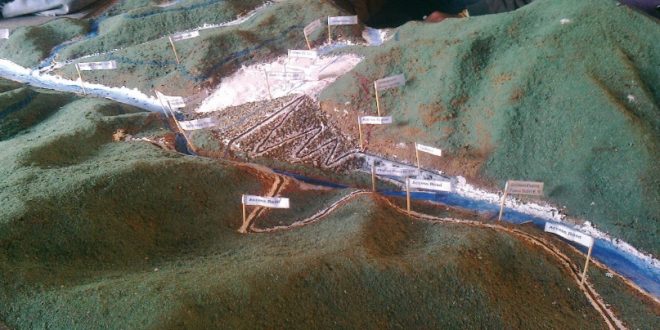
The Nepal Electricity Authority said it would soon begin preparing a detailed project report (DPR) of the long-proposed 10,800-megawatt Karnali Chisapani Multipurpose Project following a Cabinet decision on Thursday.
Minister for Communication and Information Technology Rekha Sharma, who is the government spokesperson, on Thursday told journalists that the Cabinet decided to conduct a fresh study of the project involving the state-owned power utility.
It is the largest hydropower plant envisioned in Nepal and will be developed on the Karnali river at Chisapani in Bardiya and Kailali districts.
“We will prepare a detailed project report after assessing its social and environmental impacts,” said Kul Man Ghising, the NEA managing director. “Our focus is to ensure that the project is feasible and ready so that we can get investment to develop it.”
He said that the NEA would initiate discussions on generating enough resources for this project in the study phase. The Cabinet decision follows Prime Minister Pushpa Kamal Dahal’s earlier announcement to undertake the project’s study.
“I am happy to reveal that the government is moving ahead with a vision and plans to develop mega projects like the 1,200MW Budhi Gandaki storage project and the 10,800MW Karnali Chisapani Multipurpose Project involving the NEA,” Prime Minister Dahal said in August, addressing the 38th anniversary of the power utility.
After a gap of nearly four decades, the government decided to conduct a fresh study on the project. Its last feasibility study was initiated in 1986 and completed in 1989. Himalayan Power Consultants (HPC), a consortium comprising Acres, Canada; Ebasco, USA; Shawinigan, Canada; and SNC, Canada had determined the capacity at 10,800MW.
“Our plan is to complete the DPR along with environmental and social impact studies in two to three years,” said Ghising. “These studies are expected to cost over Rs2 billion.”
As it will be the largest hydropower project in South Asia, developing it will be costly, according to officials. With Nepal aiming to be a regional hub of hydropower generation, the country will seek to generate resources from the South Asian region. “It should be developed as a regional [South Asian] project,” said Ghising. “South Asian countries like India and Bangladesh will be major markets for the electricity it generates.”
Nepal hopes to generate over 28,000MW of electricity by 2035 and there is a plan to export as much as 15,000MW. India has committed to buy 10,000MW in the next 10 years while Bangladesh has also emerged as a prospective market for Nepal’s power.
However, concerns are being raised whether the southern neighbour would grant access to its vast market and facilitate the export of Nepal’s power to Bangladesh, even though Nepal and India have agreed to do so in a joint vision statement signed in April 2022.
Ghising believes Nepal will have to attract major investors from South Asian countries for the project. Last year, some reports suggested that Indian billionaire Gautam Adani had expressed an interest.
Quoting sources, a number of media outlets reported that representatives of the Adani Group had met former energy minister Pampha Bhusal and senior officials of the energy ministry as they were interested in developing Karnali Chisapani and other projects in the river basin.
Earlier, Nepal had planned to involve both India and China in project development.
Then finance minister Bishnu Prasad Poudel had announced in the budget for the fiscal year 2016-2017 that an initiative would be taken to develop Karnali Chisapani Multipurpose Project as a tripartite project of India, China and Nepal. But little progress was made in this regard.
With India refusing to buy power from projects developed with the involvement of Chinese companies, there seems to be no prospect for trilateral cooperation to develop hydropower anytime soon.
The project was initially conceptualised in the 1960s. Nippon Koei Co Ltd (NK) of Japan had studied its feasibility between December 1962 and February 1966. The study had suggested that a run-of-the-river 1,800MW project could be developed by building a high dam at the Chisapani Gorge.
The studies and recommendations of NK were reviewed by the Snowy Mountains Hydroelectric Authority (SMHA) of Australia in 1968.
It suggested increasing the installed capacity of Karnali Chisapani to 3,600MW and erecting a gravel-fill dam instead of a concrete arch-gravity dam proposed by NK.
In 1976, the Nepal government hired two firms, Norconsult from Norway and Electrowatt from Switzerland, to review both the recommendations and resolve the differences. Both firms concurred with the SMHA’s recommendation and proposed further studies for the final designs of the Karnali Chisapani Multipurpose Project. Then, another study was done in 1986.
Even though the NEA will carry out fresh study, whether the NEA will also be involved in project development is unsure.
Ghising, however, clarified that no decision has been taken to award the project to the NEA. Its officials say that it would be challenging for it to develop the project by bridging the financial and technical resource gaps.
The biggest project that the NEA has developed with its own expertise is the 456MW Upper Tamakoshi. Currently, the utility is preparing to develop the 1,061MW Upper Arun, 635MW Dudhkoshi Storage Hydroelectric Project and the 1,200MW Budhi Gandaki.
“Karnali Chisapani is a substantially bigger project and domestic resources will not be sufficient for its development,” Tara Prasad Pradhan, deputy managing director at the NEA, told the Post in August. NEA officials say that they were not thinking of independently developing the project. “Let’s first get the project ready for development,” said Ghising.
Source : The Kathmandu Post










